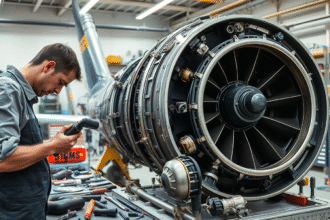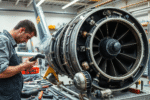As you fly through the skies, air traffic control is key to your safety. With more people flying, the danger of mid-air collisions grows. Air traffic control works hard to stop these accidents, keeping aviation safety at the forefront.
air traffic control prevents mid-air collision
Rest easy knowing air traffic control is always on the lookout for collisions. They use cutting-edge systems and strict rules to keep flights safe. Their collision prevention efforts protect everyone on board.
Key Takeaways
- Air traffic control is vital for avoiding mid-air collisions.
- Aviation safety is a top priority in the aviation world.
- Advanced systems and protocols ensure safe flights.
- Collision prevention measures protect lives.
- Air traffic control is essential for passenger safety.
The Critical Role of Air Traffic Control in Aviation Safety
Air traffic control is key to keeping the skies safe for millions of travelers each year. It prevents mid-air collisions by using technology, following rules, and relying on human skills.
air traffic control
The Primary Mission: Maintaining Separation Between Aircraft
The main job of air traffic control is to keep planes apart. They use separation standards to set safe distances between planes. This is vital to avoid crashes.
The Three Core Services: Communication, Navigation, and Surveillance
Air traffic control offers three main services: communication, navigation, and surveillance. Good communication protocols help controllers talk to pilots. Navigation helps pilots stay on track. Surveillance, like radar, lets controllers watch planes and keep them safe. These services are the heart of air traffic control’s role in aviation safety.
The Evolution of Air Traffic Control Systems
The journey of air traffic control systems has been incredible. It’s filled with tech advancements and lessons from past incidents. As flying became more common, the need for safe and efficient air traffic grew. This need pushed for new ATC systems.
From Bonfires to Radar: Historical Development
At first, air traffic control used simple signals like bonfires and radio. Radar came later, making it easier for controllers to track planes.
evolution of air traffic control systems
Major Incidents That Shaped Modern ATC Protocols
Big incidents have changed ATC rules a lot. For example, the Tenerife airport disaster in 1977 showed how key clear talk is. It led to standard ways of speaking. These events have made safety rules better.
The Transition to NextGen Technologies in the US
The US is moving to NextGen tech, like ADS-B and PBN. This change aims to make flying safer, more efficient, and better for the environment.
| Technology | Description | Benefits |
| Radar | Uses radio waves to determine aircraft position | Improved accuracy, increased safety |
| ADS-B | Broadcasts aircraft position, altitude, and velocity | Enhanced surveillance, reduced separation minima |
| PBN | Enables precise navigation through airspace | Increased efficiency, reduced fuel consumption |
Understanding Airspace Structure and Classification
To get the hang of air traffic control, knowing how airspace is set up is key. It’s divided into various types to keep planes safe and moving smoothly.
Airspace is sorted by how complex it is and the kind of air traffic it has. This system helps manage air traffic and lowers the chance of planes crashing.
The Different Classes of Airspace (A through G)
In the U.S., airspace is split into seven types, from A to G. Each class has its own rules and air traffic control service level.
- Class A Airspace: This is the strictest area, where all planes must follow strict rules and be kept apart.
- Class B Airspace: Around big airports, this area has strict entry rules and is closely watched.
- Class C Airspace: Near smaller but important airports, this area needs specific communication with air traffic control.
- Class D Airspace: Around airports with a tower, pilots must talk to air traffic control.
- Class E Airspace: This is controlled airspace that isn’t A, B, C, or D.
- Class G Airspace: This is the uncontrolled area where air traffic control services aren’t available.
Special Use Airspace and Temporary Flight Restrictions
There’s more to air traffic management than just the standard classes. Special use airspaces and temporary flight restrictions are also key.
Special Use Airspace includes areas for military operations, prohibited zones, and restricted areas. These places have rules about what can happen there.
Temporary Flight Restrictions (TFRs) are put in place for reasons like natural disasters, security events, or big sports games. Pilots need special permission to fly in these areas.
- TFRs are announced through NOTAMs (Notices to Airmen).
- Pilots must know about current TFRs to avoid breaking the rules.
Knowing about the different airspace classes and special areas helps you navigate air traffic control better.
Inside an Air Traffic Control Facility
The safety of air travel depends a lot on air traffic control facilities. These places guide planes during takeoff, landing, and in the air. They make sure planes don’t crash into each other. There are different types of facilities, each with its own job.
Airport Traffic Control Towers (ATCT)
Airport Traffic Control Towers, or ATCTs, help planes move safely on the ground and in the air. Controllers use their eyes and radar to help planes take off and land. They tell pilots how to stay safe from other planes.
Terminal Radar Approach Control (TRACON)
TRACON facilities handle planes coming in and going out of nearby airports. Controllers use radar to guide planes from the sky to the ground. They pass planes to ATCTs for landing or to ARTCCs for flying further.
Air Route Traffic Control Centers (ARTCC)
ARTCCs manage planes when they’re flying between airports. They keep planes safe from other planes and mountains. ARTCCs work with TRACONs and other ARTCCs to keep flying smooth and safe.
In short, different air traffic control facilities work together to make flying safe and efficient. Knowing about ATCTs, TRACONs, and ARTCCs shows how complex and coordinated air travel is.
The Technology Behind Collision Prevention
Collision prevention in air traffic control uses surveillance systems and alert technologies. These tools give accurate and timely info to controllers and pilots. This ensures air travel is safe.
Primary and Secondary Surveillance Radar
Primary Surveillance Radar (PSR) and Secondary Surveillance Radar (SSR) are key in air traffic control. PSR uses radio waves to detect aircraft. SSR gets more info from aircraft transponders, like identity and altitude.
Together, they help controllers track aircraft well. This is vital for safety, like during busy air traffic times.
| Radar Type | Function | Information Provided |
| Primary Surveillance Radar (PSR) | Detects aircraft using radio waves | Aircraft position |
| Secondary Surveillance Radar (SSR) | Rely on transponders for detailed info | Aircraft identity, altitude, and position |
Automatic Dependent Surveillance-Broadcast (ADS-B)
ADS-B is a cutting-edge tech that gives precise aircraft info. It uses GPS to know an aircraft’s location and speed. It shares this info with controllers and nearby planes.
ADS-B is better than old radar systems. It’s more accurate and gives info in real-time. The FAA says ADS-B makes flying safer and more efficient.
“ADS-B is a significant improvement over traditional surveillance radar, providing more precise and timely information.”
FAA Official
Traffic Collision Avoidance System (TCAS)
TCAS is a system in planes that warns pilots of possible collisions. It talks to nearby planes and tells pilots how to avoid crashes.
TCAS is a key safety tool. It helps prevent mid-air crashes by giving pilots timely warnings.
- TCAS interrogates nearby aircraft transponders.
- Provides resolution advisories to pilots.
- Acts as a safety net to prevent mid-air collisions.
How Air Traffic Control Prevents Mid-Air Collision
As you fly through the skies, air traffic control works hard to keep you safe. They prevent mid-air collisions by following strict rules, using advanced systems, and handling emergencies well.
Maintaining Vertical and Horizontal Separation Standards
Air traffic control keeps you safe by setting vertical and horizontal separation standards for planes. They use different altitudes for vertical separation and keep planes apart horizontally. These rules are key to avoiding crashes.
Conflict Detection and Resolution Procedures
Conflict detection finds possible crashes between planes. Controllers use radar and surveillance systems to watch planes and predict problems. If a problem is found, they change the flight path or altitude to avoid a crash.
Handling Aircraft Emergencies and Deviations
If there’s an emergency or a plane goes off course, air traffic control acts fast. They’re trained for many situations, like medical emergencies or system failures. They work with pilots to keep everyone safe.
Coordination Between Different ATC Facilities
It’s important for air traffic control to work together. Controllers talk to other facilities to smoothly hand over planes. This keeps safety as planes move between different areas.
By following strict rules, solving conflicts, handling emergencies, and working together, air traffic control is key to safe flying. They prevent mid-air collisions and keep air travel safe.
Communication Protocols That Keep You Safe
Standardized communication protocols are key to your safety in the skies. Air traffic control (ATC) uses clear talk to keep planes apart. They follow strict rules for talking and have plans for when communication breaks down.
Standardized Phraseology and Why It Matters
Standardized talk is vital in ATC. It cuts down on mix-ups by using a common language. This clear talk is critical for safety, even in tense moments.
Readback Requirements and Verification Procedures
ATC makes pilots repeat back important messages. Controllers then check to make sure they got it right. This step helps avoid mistakes that could be risky.
How Controllers Handle Communication Failures
Even with good plans, communication can fail. Controllers are ready for this with backup plans. They might switch to other systems or use planes to relay messages. These steps keep flying safe even when things go wrong.
Following these rules, ATC keeps you safe on your flight. You’ll reach your destination without a hitch.
The Human Element: Air Traffic Controller Training and Performance
Air traffic controllers are key to keeping the skies safe. They go through tough training to handle the challenges of air traffic. They need to know a lot and make quick decisions when it matters most.
Selection Process and Initial Qualification Requirements
Starting as an air traffic controller is tough. You must pass background checks, medical exams, and special tests. First, you need to finish a training program approved by the FAA.
Simulation Training and On-the-Job Experience
Simulation training is vital for learning to handle different situations. It’s like a real-life practice. Then, you get on-the-job training with experienced controllers to improve your skills.
Managing Stress and Cognitive Workload
Stress and workload are big challenges for air traffic controllers. They work in high-stress situations. To stay sharp, they use techniques like prioritizing, clear talking, and taking breaks.
| Training Component | Description | Importance |
| Simulation Training | Realistic environment simulation for practice | High |
| On-the-Job Experience | Hands-on experience under supervision | High |
| Stress Management | Techniques to manage workload and stress | Essential |
Challenges and Limitations in Collision Prevention
Air traffic control faces many challenges in preventing collisions. As more people fly, managing the skies safely gets harder. This makes it tough to keep everyone safe.
Weather Impacts on ATC Operations
Weather affects air traffic control a lot. Bad weather can cause poor visibility, turbulence, and other dangers. These make flying and managing air traffic harder.
Controllers have to make fast decisions to keep flights safe. They try to avoid delays as much as they can.
Dealing with Airspace Congestion
Airspace congestion is a big problem. More planes mean more chances for conflicts. Controllers use new tech and strategies to keep planes safe.
The Threat of Unauthorized Drones and Airspace Violations
Unauthorized drones are a new danger. They can accidentally or on purpose enter no-fly zones. This risks planes and people.
Air traffic control works with authorities to stop these dangers. They use rules and watch the skies closely.
In summary, solving these problems needs better tech, training, and working together. This will keep air travel safe for everyone.
Conclusion: The Future of Air Traffic Safety
Air traffic control is key to avoiding mid-air collisions and keeping flying safe. NextGen technologies are changing how we manage air traffic. They make flying safer and more efficient.
Looking ahead, air traffic safety will keep getting better. NextGen will help reduce accident risks even more. Air traffic control will get even better with new surveillance, navigation, and communication systems.
The future of air traffic safety is bright. There’s a big push to update air traffic control systems. As these updates happen, flying will get safer and more efficient.
FAQ
What is the primary mission of air traffic control?
Air traffic control’s main goal is to keep planes apart. This ensures they don’t crash into each other.
How does air traffic control prevent mid-air collisions?
They keep planes apart by setting safe distances. They also solve conflicts and handle emergencies. This keeps flights safe.
What are the three core services provided by air traffic control?
Air traffic control offers three main services. These are communication, navigation, and surveillance. Together, they prevent crashes and keep flights safe.
What is the role of Automatic Dependent Surveillance-Broadcast (ADS-B) in air traffic control?
ADS-B gives air traffic control real-time info on planes. This includes where they are, how high, and how fast. It helps prevent crashes.
How do air traffic controllers handle communication failures?
If communication fails, controllers follow set procedures. They use backup systems and check plane info. They also work with other facilities to keep flights safe.
What is the purpose of standardized phraseology in air traffic control communication?
Standardized phraseology makes sure messages are clear. It helps avoid mistakes that could cause crashes.
How does weather impact air traffic control operations?
Weather can change air traffic control’s work. It can make it hard to see, affect how planes fly, and need changes in routes or heights.
What is the Traffic Collision Avoidance System (TCAS)?
TCAS is a system in planes. It warns pilots of possible crashes and helps avoid them.
How do air traffic controllers manage stress and cognitive workload?
Controllers deal with stress through training and experience. They also use strategies like focusing on tasks and taking breaks. This helps them stay sharp.







